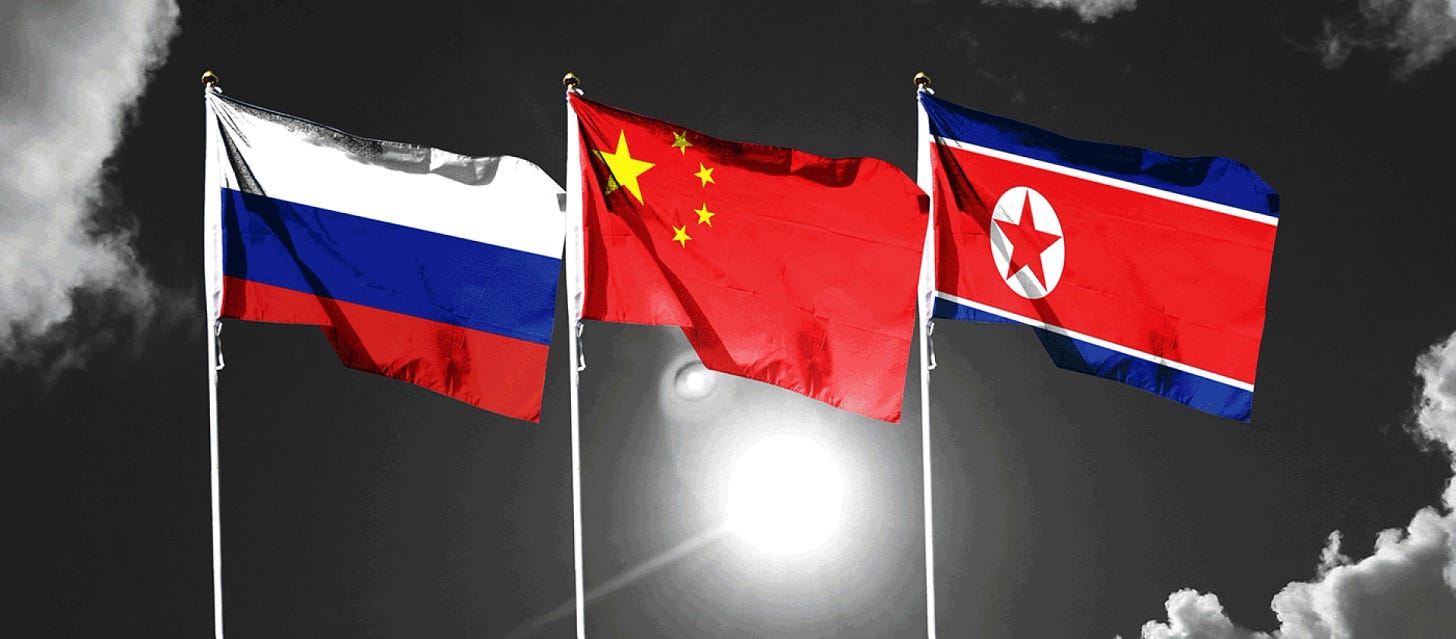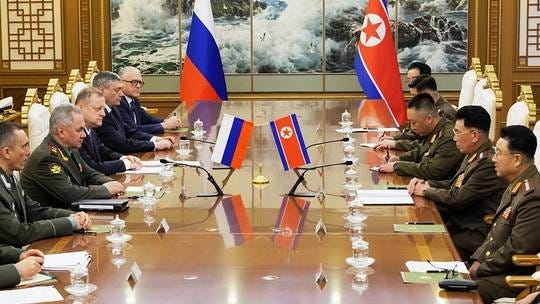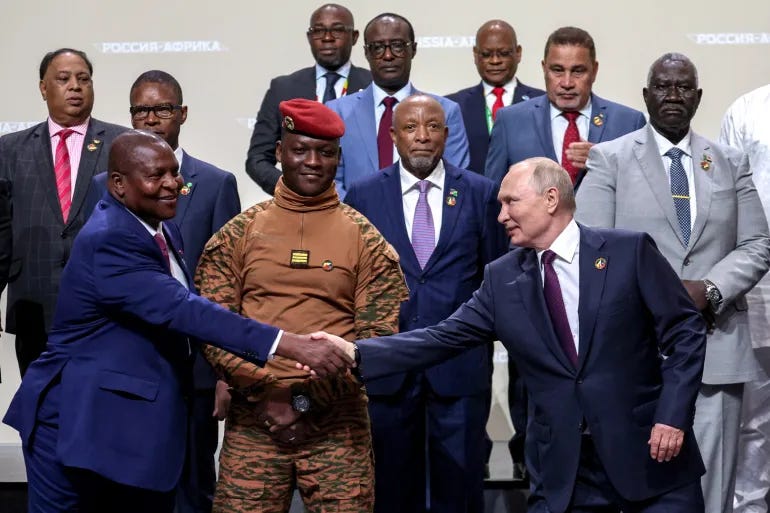Russia, China, and DPRK (aka, “North Korea”): Pivoting the Axis of Power towards a New Multipolar World Order

In the ever-evolving chessboard of global geopolitics, the Far East stands as an enigmatic and highly contested region. A product of a tumultuous history, shaped by the complex legacy of the Cold War and a myriad of strategic alliances and rivalries, the region has emerged as a critical fulcrum in the balance of global power.
Today, we find ourselves on the precipice of monumental shifts within this geopolitical cauldron. The focal point of this power shift is none other than North Korea, long considered an isolated nation, but now gradually transforming into a crucial pivot of international strategy.
A strategic dance is unfolding, orchestrated by the adept manoeuvres of China and Russia. As they say, fortune favours the bold – and the bold, it seems, are the rising eastern powers.
Recently, Russian Defense Minister Sergey Shoigu made an unprecedented state visit to Pyongyang, which took place from July 25th to the 27th. Accompanied by a military delegation, this significant event was the first of its kind in the post-Soviet era.
The timing, the 70th anniversary of the armistice leading to a cessation of Korean War hostilities, was undeniably potent. It wasn’t merely a diplomatic courtesy – it was a statement of Russia’s reemergence as a dominant player on the global stage, a force to be reckoned with, quite literally puncturing a hole into the fortress of sanctions the US has painstakingly built around North Korea.

Examining the matter beyond the surface of diplomatic formalities, the conducted tour of North Korea’s missile arsenal, including its newest marvel, the ICBM Hwasong-18, carries a tremendous geopolitical significance.
This isn’t just a display of Pyongyang’s technological prowess; it’s a tacit signal to Washington and its allies about the shifting power dynamics in the region. It’s an indirect reminder of the potency of the partnerships they may be contending against.
This chapter in the geopolitics of the Far East is shifting from speculation to an evocative, tangible reality.
The visit coincided with President Vladimir Putin chairing the Russia–Africa Summit in St. Petersburg, both a grand symphony and a signal of Russia’s international clout. The crescendo of this was the VIP tour of North Korea’s arsenal of nuclear-capable missiles for the Russian military delegation, a show-and-tell orchestrated by Kim Jong Un himself.
This intimate look into North Korea’s missile capabilities, including its newest achievement, the Hwasong-18, was a dramatic display of the hermit kingdom’s military prowess and geopolitical assertiveness.
In the grand tradition of international diplomacy, a handwritten letter from Putin to Kim was presented. While the contents remain a mystery, the statement was clear – the roots of Russia-North Korea friendship run deep, and they are to be nurtured, particularly in these times of shifting security landscapes.
This sentiment was echoed by Russia’s Defense Ministry, which acknowledged Shoigu’s visit as an essential step in strengthening bilateral military ties and expanding cooperation.
The letters exchanged and the meetings conducted signal far more than simple diplomatic courtesy. They represent a comprehensive, strategic alignment between Russia and North Korea, particularly in the critical areas of national defence and security.
They underscore an emerging consensus, a shared understanding of the regional and international security landscape. The language of ‘strategic and tactical collaboration and cooperation’ shouldn’t be overlooked; it signifies an intense, concerted response to the simmering geopolitical tensions.
The ensuing narrative spun by both nations speaks volumes. It speaks of mutual concerns in defence, security, and the volatile regional environment in the Far East. One can glean a clear reference to “strategic and tactical collaboration and cooperation,” which hints at a potentially groundbreaking chapter in this international saga.
The geopolitical ballet gains further complexity with the concurrent visit of Li Hongzhong, Vice Chairman of China’s National People’s Congress Standing Committee. The synchronized nature of these diplomatic overtures by Russia and China seems to counteract the Biden Administration’s push towards a trilateral alliance with Washington, Tokyo, and Seoul.
Last year, the election of pro-western South Korean president Yoon Suk-Yeol marked a significant shift in the region’s political landscape. Yoon’s realignment towards the West and distancing from Moscow and Beijing, coupled with a more hawkish approach towards Pyongyang, has intensified regional tensions.
The blueprint of Washington’s approach to the Far East is quite reminiscent of its strategies in the Middle East, where an atmosphere of fear and uncertainty has long been propagated to justify its military presence and substantial arms exports. The difference, however, is that the real targets of Washington’s Far East strategy are China and Russia.
The geopolitical ramifications of deepening military cooperation between Washington and Seoul cannot be underestimated. As the confrontations between the two Koreas edge towards escalation, it’s not just regional stability at stake, but the equilibrium of international relations.
The Biden-Yoon Washington Declaration is a clear indication of America’s hardened stance, exacerbating the cycle of provocation and retaliation that threatens to destabilize the region.
It’s undeniable that the US, with its latest aggressive stance, is destabilizing the regional equilibrium. Its provocations towards Pyongyang and strategic undermining of the Korean Peninsula’s stability are seen as calculated moves designed to counter the Sino-Russian axis. The recent visits by two US nuclear submarines to South Korean naval bases in July exemplify this strategy.
Amidst this international power play, the Arctic shipping route is emerging as a significant point of economic and strategic interest. As the polar ice caps melt, new opportunities for trade between Asia and Europe are opening up.
A shipping route through the Arctic could potentially shorten the maritime distance between Europe and Northeast Asia by almost a third compared to the currently used Suez route. This is a game-changing development that falls outside American control, thereby heightening its strategic importance for both China and Russia.
The centrepeice of this shifting dynamic is North Korea’s Rajin Port, the most northerly ice-free port in Asia. It holds the potential to become a significant “logistics hub” if linked to the Trans-Siberian Railway. The Special Economic Zone in Rajin is a crucial junction in the Arctic shipping network and is ideally positioned to leverage the Northern Sea Route’s potential.
The Arctic shipping route is far more than a time-saving trade corridor. Its strategic value in this era of heightened power competition is profound, as it sidesteps American control and potentially reshapes the global trade map. Amid escalating geopolitical tensions, the early planning and precautions around diversifying shipping routes could be a key strategic move for China’s long-term economic and trade security.
While the US continues to fan the flames of tension in North Korea, it is the eastern powerhouses that may eventually benefit from the ensuing geopolitical reshuffle.
Shoigu’s groundbreaking visit to Pyongyang aims not just at warming bilateral relations but also integrating North Korea into the geoeconomics of Eurasia. Anticipate that these discussions will figure prominently during Putin’s upcoming visit to China in October, potentially leading to new developments within the framework of the Belt and Road Initiative.
With the right infrastructure and political stability, North Korea’s Rajin Port could become an instrumental cog in the wheel of Eurasian trade. It could potentially transform into a crucial link between the Arctic shipping network and the bustling ports of Northeast Asia.
It’s a tantalizing prospect that, if realized, would offer a counter-narrative to America’s attempts to contain North Korea.
The implications of Shoigu’s landmark visit to Pyongyang are far-reaching. It’s not just about improving bilateral relations or boosting national security. It’s a blueprint for a greater geopolitical vision, a means to pull North Korea out of isolation and integrate it into the broader geoeconomics of Eurasia.
This is a vision not limited by zero-sum games or short-term gain. Instead, it looks to a future defined by cooperation, mutual benefit, and regional stability
In this evolving multipolar world, Russia and China are two pillars standing shoulder to shoulder, but with their roles sharply delineated. Russia is providing the kinetic backbone to the world’s unfolding geopolitical narrative, holding back the full brunt of NATO’s might through its ongoing SMO in Ukraine.
This operation isn’t just about the demilitarization and de-Nazisification of Ukraine, but it also serves as a linchpin in Russia’s strategic counter-offensive against the West’s hybrid warfare. Russia’s decisive response is reshaping the global power dynamic, undercutting NATO’s aggressive posturing, and setting the stage for a new era of geopolitical recalibration.
As Russia’s military might and industrial prowess keeps the spotlight, China, meanwhile, navigates the intricate world of diplomacy and economic bridges. Continuing to build what Belarusian President Lukashenko aptly coined the ‘Golden Globe,’ China is solidifying relationships within the Global Majority.
This extended alliance of the Global South, united in shared aspirations and challenges, is the rising force that is gradually shifting the axis of the global order.
This emerging reality underscores Russia’s pivotal role. The recent Russia-Africa Summit chaired by President Putin is a testament to this. It is an undeniable evidence of Russia’s significant strides into Africa, marking its growing influence in this historically underestimated continent.
 Putin and participants of the Russia-Africa summit pose for a photo in St Petersburg on July 27th (TASS)
Putin and participants of the Russia-Africa summit pose for a photo in St Petersburg on July 27th (TASS)
The notion of ‘Russian isolation’ is being dismantled, piece by piece, with every strategic move. Far from being isolated, Russia, along with China, is aligning itself with the Global Majority.
The arrogant Western minority, long accustomed to dictating the world’s narrative, now faces the uncomfortable truth of their waning influence. The world is larger and far more complex than the narrow lens through which they have been accustomed to viewing it
Some Final Thoughts
As we draw our narrative to a close, we find ourselves staring into the heart of a fundamental recalibration in global geopolitics. Far from being a distant probability, it is an active, ongoing process reshaping the contours of global power dynamics even as we speak.
The Far East, once a mere stage for external power plays, is rapidly transforming into a formidable arena dictating its own rules of the game.
As Russia and China consolidate their strategic alliances and redefine their roles on the international stage, the traditional narrative of unipolar dominance led by the West crumbles before our eyes.
The seismic shifts we are witnessing are not merely disruptions; they represent the harbingers of a new, multipolar world order, a brave new world in which power is distributed more evenly across multiple centers of influence.
This multipolar world is not a figment of speculative futurism – it is a reality being forged in the crucibles of North Korea, Russia, and China.
The intricate dance of diplomacy, the strategic power play, and the evolving alliances in the Far East are all parts of this great transformation. North Korea, once considered an isolated outpost, is progressively becoming a pivot, a crucial point around which these changes are revolving.
As the partnerships solidify and a distinctive Eastern vision for North Korea emerges, we are witnessing more than just a regional metamorphosis. These events signal a profound shift in the global power balance. Multipolarity is not on the horizon – it is here, altering the rules of the game, shaping new alliances, and redefining international relations.
As we grapple with these changes, it becomes apparent that the arrogant assumption of permanent Western dominance is fading into the annals of history. The Global Majority is emerging as a formidable force, heralding a new era where the geopolitical narrative is written by a diverse array of voices, and not just a Western minority.
The Far East, once perceived through a lens of conflict and controversy, is metamorphosing into a nexus of possibilities and power shifts. Are we on the precipice of a global geopolitical revolution? It would seem so. The Eastern powers are boldly charting a course through this unexplored territory, crafting a future defined by cooperation, mutual respect, and stability.
As the global community watches this transformative phase, the reality becomes clear – the geopolitical chessboard, once assumed to be set in stone, is not fixed. It’s dynamic, reflective of the ebbs and flows of international politics.
This transformation, this shift from a unipolar to a multipolar world, is not just a future possibility – it is our unfolding reality. In this grand reshaping of the world order, it is not just the pieces on the chessboard that are moving. The chessboard itself is changing.
By Sarah and Gerry
Published by DD Geopolitics
Republished by The 21st Century
The views expressed in this article are solely those of the author and do not necessarily reflect the opinions of 21cir.com
